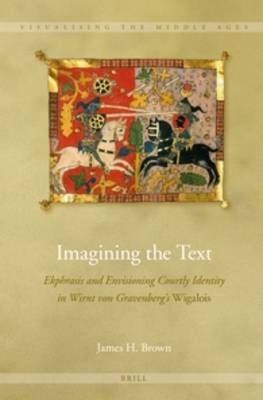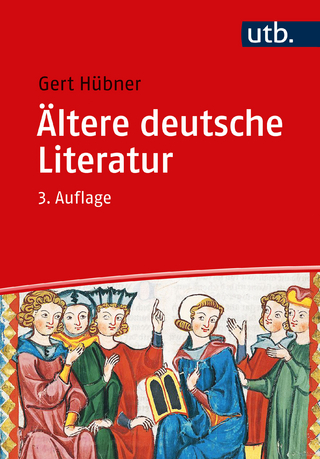
Imagining the Text
Brill (Verlag)
978-90-04-26918-7 (ISBN)
In Imagining the Text, James Brown examines ekphrasis – the verbal representation of a visual representation – in Wirnt von Gravenberg’s thirteenth-century Arthurian romance Wigalois, one of the most popular and enduring stories in the Middle High German literary tradition. Through close reading of the text and examining illustrated Wigalois manuscripts, early print editions, and frescoes, Brown explores how ekphrasis structures the narrative, harmonizes potential conflicts in the text, and contributes to the construction of courtly identity. Imagining the Text demonstrates that the vibrant symbiosis of word and image is crucial to the poem’s sustained popularity for more than six hundred years, and contributes to the history of the book and to the study of medieval and modern modes of perception.
James H. Brown is Teaching Assistant Professor of German at North Carolina State University. He earned his Ph.D. in 2006 from the Department of Germanic and Slavic Languages and Literatures at the University of North Carolina at Chapel Hill.
Contents
Acknowledgments ix
List of Illustrations x
Introduction: Imagining the Text 1
Wigalois and Ekphrasis 1
What Was Ekphrasis? 7
Wigalois: Summary and Reception 9
Chapter Outline 15
part 1
Imagining the Text
1 Ekphrasis as a Structuring Device 21
Dividing the Narrative 22
Ekphrasis as a Structuring Device 25
Setting the Stage: The Magic Belt 25
From Boy to Man, Part One: The Stone of Virtue 32
From Boy to Man, Part Two: The Golden Wheel 35
Through God All Things Are Possible: Japhite’s Tomb 42
The Final Stages: Larie’s Tent 47
Conclusion 53
2 Ekphrasis as an Integrative Device 55
Ekphrasis and Integration 58
Harmonizing Families and Fictional Worlds: The Magic Belt 58
Arthurian and Faerie Realms in Wigalois 59
Integrating the Arthurian and the Wondrous 63
The Stone and the Arthurian Circle 67
The Golden Wheel and Religious Elements 71
Triuwe and Riuwe: Japhite’s Tomb 78
The Tent and the Final Harmonization 85
Conclusion 87
3 Ekphrasis and Courtly Identity 89
Courtly Identity and Self-representation 89
Courtly Ideals and Romance 95
Ekphrasis and Courtly Identity in Wigalois 98
Ekphrastic Belts and the Construction of Courtly Femininity 98
The Magic Belt and Chivalric Masculinity 104
The Stone and Storytelling 106
Gwigalois’s Wheel and the Literary Uses of Heraldry 111
The Tomb’s Inscription and Courtly Literary Culture 115
Larie’s Tent, Courtliness, and Virtual Splendor 124
Conclusion 131
part 2
The Text Imagined
4 Ekphrasis and Visualization Strategies in the Illustrated Wigalois
Manuscripts 135
Heraldry and Integration: Manuscript B 138
Basic Description of the Manuscript 138
Heraldic Visualization 141
Integration in Manuscript B 147
Didactic hövescheit: Codex Donaueschingen 71 155
Basic Description of the Manuscript 155
The Role of the Captions 157
Deictic and Didactic Visualization 161
Conclusion 166
5 Re-imagining Narrative in Wigoleis vom Rade 168
The Strassburg Wigoleis and Its Layout 172
A Reconceived Text for a New Audience 175
A Question of Literary Quality? 175
Diffferent Audiences 178
Reading and Literacy 180
Visuality, Structure, and Narrative 183
Eyewitnessing and a New Attitude toward Description 183
Woodcut and Caption: Guiding and Linking 191
Narrative and Illustrative Simplifijication 195
Envisioning Courtliness in the Strassburg Woodcuts 199
Conclusion 202
6 Literature and Legitimization: The Wigalois Frescoes at Runkelstein
Castle 204
Material Visualizations of German Vernacular Literature 206
The Vintler Brothers and the Murals at Runkelstein 209
Ernst Karl von Waldstein and the Wigalois Frescoes 216
Description of the Wigalois Images at Runkelstein 218
Why Wigalois? Possible Interpretations 222
Conclusion: Understanding the Book 226
Bibliography 229
Index 241
Illustrations 245
| Erscheint lt. Verlag | 4.12.2015 |
|---|---|
| Reihe/Serie | Visualising the Middle Ages ; 10 |
| Verlagsort | Leiden |
| Sprache | englisch |
| Maße | 155 x 235 mm |
| Gewicht | 590 g |
| Themenwelt | Kunst / Musik / Theater ► Kunstgeschichte / Kunststile |
| Geschichte ► Allgemeine Geschichte ► Mittelalter | |
| Geisteswissenschaften ► Sprach- / Literaturwissenschaft ► Anglistik / Amerikanistik | |
| Geisteswissenschaften ► Sprach- / Literaturwissenschaft ► Literaturwissenschaft | |
| ISBN-10 | 90-04-26918-5 / 9004269185 |
| ISBN-13 | 978-90-04-26918-7 / 9789004269187 |
| Zustand | Neuware |
| Haben Sie eine Frage zum Produkt? |
aus dem Bereich


